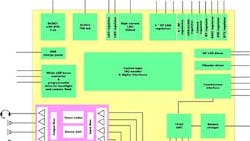Power Management SoC Supports Latest Applications Processors
Dialog Semiconductor (www.Dialog-Semiconductor.com) has launched a power management and audio IC designed specifically to support the latest generation of application processors in emerging applications such as smartphones, portable multimedia devices (PMP), PDAs and personal navigators. The DA9034 power management and audio controller IC addresses the growing need to merge more functions so that battery life can be prolonged and smaller handheld solutions can be realized. The chip integrates over 50 main functions including a 24-bit stereo subsystem, a 1400-mA buck converter and what the company claims are the first linear regulators to feature dynamic voltage management (DVM).
A system-on-a-chip (SoC), the DA9034 aims to reduce the number of ICs required in the portable device, while cutting pc board area by more than half. The power management and audio chip supports applications processors such as Intel’s Monahans, which are fabricated in 90-nm technologies and below.
The chip connects directly to the battery, providing complete control of all power management, battery charging, audio (stereo audio playback, microphone, loudspeaker and handsfree functions), white and general purpose LED drivers, USB interface and many other functions that need to be controlled in a portable multimedia device (see the figure). The high level of integration offered by this device begs comparison with some other recently introduced power management chips, which also offer multiple regulators in combination with various audio, lighting, and other functions.*
The DA9034 includes 18 programmable LDOs that create stable, low-noise supply voltages for other ICs (other than the applications processor) found in the portable device. Two high-efficiency buck converters generate high-current, low-voltage supplies to the processor core and memory, while supporting digitally controlled DVM with programmable voltage and slew rate control. An additional boost converter generates a programmable supply voltage up to 25 V and 1.3 A. That supply may be used to power three individual LED backlighting channels and high power flash or video light LEDs.
A full integrated audio subsystem on the DA9034 includes a 24-bit hi-fi stereo DAC with programmable sample rates up to 48 kHz and automatic sample rate conversion. These features make the chip suitable for playback of multimedia sources such as MP3 and WMA files.
Among the other integrated features are a voice codec with programmable filtering and 8-kHz, 16- kHz and 32 kHz sampling; two microphone amplifiers; and low noise input and output audio multiplexers. The chip also features capacitorless, low-distortion 16-Ω headphone drivers; a 0.5-W loudspeaker driver with volume and anti-pop control; and a 32-Ω earpiece driver.
The flexible output switching matrix enables any signal source to be output via headphones, earpiece or high power handsfree drivers. The audio subsystem has advanced power management control to minimize quiescent current and consumes as little as 9 mW in the 8-KHz voice mode and 35 mW in the 48- kHz HiFi mode.
The backlight drivers feature an advanced dimming function that ramps the LED current, giving a smooth change in light output. A 10-bit ADC is integrated for user measurements and features three channels with programmable upper and lower threshold limits and an automatic measurement and averaging mode to simplify software. The ADC also supports a 4-wire touchscreen interface.
Battery management consists of a programmable battery charger supporting constant voltage, constant current (up to 1.4 A), pulse and trickle charging from either USB or external adapters. The battery management subsystem includes a UART supporting intelligent battery communication, full time supervision with overvoltage and undervoltage protection, a battery temperature measurement and a reverse mode to allow powering of accessories from the phone system connector.
The LDOs in the DA9034 provide a high PSRR of typically 80 dB at 217 Hz, and very low quiescent current, enabled by the company’s Smart Mirror technology. Smart Mirror regulators mirror the output current demand back to the bias generator, which allows the bias to be reduced automatically as demand falls, to enable dynamic quiescent current control.
That capability results in high PSRR and dynamic performance over a wide range of operating currents. This autonomous adaptive bias control also removes the need for a low-power operating mode and consequently, the need for user intervention to switch to a lower power mode under light loads. Using this technique at 10 mA, Dialog’s LDOs offer typically 99% current efficiency, consuming less than 15 µA.
The DA9034 is available now in sample quantities in a 196-pin BGA that measures 8 mm x 8 mm x 1 mm. Unit pricing is $3.30 each in quantities of 100,000. For more information including a detailed product brief, email [email protected].
*See " Portable Power Management Inspires Mega Integration," Power Electronics Technology, June 2006, pages 54 and 56.
